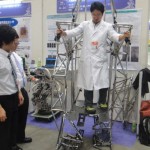Archive for 2011
Effects of intensive arm training with an electromechanical orthosis in chronic stroke patients: a preliminary study
- Тип контента: Научная статья
- Номер документа: 3595
- Название документа: Effects of intensive arm training with an electromechanical orthosis in chronic stroke patients: a preliminary study
- Номер (DOI, IBSN, Патент): 10.1016/j.apmr.2011.05.021
- Изобретатель/автор: Sono, T.S., Rocha, D.N., Pinotti, M., Junior, F.L., de Araújo, R.C.
- Правопреемник/учебное заведение: Department of Mechanical Engineering, Universidade Federal de Minas Gerais-UFMG, Belo Horizonte, Brazil
- Дата публикации документа: 2011-09-29
- Страна опубликовавшая документ: Бразилия
- Язык документа: Английский
- Наименование изделия: Не заполнено
- Источник: http://www.ncbi.nlm.nih.gov/pubmed/21959035
- Вложения: Нет
- Аналитик: Helix
 OBJECTIVES:
OBJECTIVES:
To evaluate the use of an electromechanical device, comprising an exoskeleton, a static orthosis, and a glove, for functional rehabilitation of the elbow and hand in patients with hemiparesis, and to compare it with physical therapy rehabilitation.
DESIGN:
Pretest-posttest design.
SETTING:
Rehabilitation laboratory.
PARTICIPANTS:
Volunteer sample of persons (N=12) with persistent hemiparesis from a single, unilateral stroke within the past 3 to 36 months.
INTERVENTIONS:
The volunteers were randomly divided into 2 groups. One group was treated with a conventional program of physiotherapy, and another group participated in a training program in which an electromechanical orthosis was used. All volunteers received 24 sessions, held 3 times a week for 8 weeks.
MAIN OUTCOME MEASURES:
Modified Ashworth Scale (MAS), Fugl-Meyer Assessment (FMA), and electromyogram (EMG) amplitude.
RESULTS:
No statistical difference was found in the initial and final values of the MAS. Both groups showed a significant increase for the total scores of the FMA. However, only the group treated with the orthosis showed an increase in FMA scores related to the wrist and hand joint. The EMG analysis showed increased EMG amplitudes for all muscles in the group treated with the orthosis, whereas the group treated with physiotherapy showed gains in electromyographic activity only in the extensor digitorum communis. Intergroup comparison showed that the initial FMA scores of the wrist/hand were higher in the group treated with physiotherapy. However, after training, the scores in the group that used the orthosis were equivalent to those of the physiotherapy group.
CONCLUSIONS:
The results suggest that this device can be an auxiliary tool to help the conventional rehabilitation program of motor function of the affected upper extremity.
Категория: Ищем научные статьи | Нет комментариев »
Новая модель движения экзоскелета использует переменный цент тяжести.
- Тип контента: Новостная статья
- Номер документа: 4599
- Название документа: "Экзоскелет" работающий без электричества (видео)
- Номер (DOI, IBSN, Патент): Не заполнено
- Изобретатель/автор: Не заполнено
- Правопреемник/учебное заведение: Не заполнено
- Дата публикации документа: 2011-09-28
- Страна опубликовавшая документ: Россия
- Язык документа: Русский
- Наименование изделия: Не заполнено
- Источник: http://www.24gadget.ru/1161046818-ekzoskelet-rabotayuschiy-b
- Вложения: Не заполнено
- Аналитик: Helix
 Японские ученые создали двуногого робота, который отличается исключительной устойчивостью. В действие робота приводят движения человека. Машина может ходить, используя центр тяжести человека, который ею управляет.
Японские ученые создали двуногого робота, который отличается исключительной устойчивостью. В действие робота приводят движения человека. Машина может ходить, используя центр тяжести человека, который ею управляет.
Категория: Управление | Нет комментариев »
Initial analysis of EMG signals of hand functions associated to rehabilitation tasks
- Тип контента: Научная статья
- Номер документа: 1368
- Название документа: Initial analysis of EMG signals of hand functions associated to rehabilitation tasks
- Номер (DOI, IBSN, Патент): 10.1109/ROBIO.2009.4913058
- Изобретатель/автор: Low, K.H., Lim, H.B., Huang, Y.Y.
- Правопреемник/учебное заведение: Sch. of Mech. & Aerosp. Eng., Nanyang Technol. Univ., Singapore
- Дата публикации документа: 2009-05-08
- Страна опубликовавшая документ: Сингапур
- Язык документа: Английский
- Наименование изделия: Не заполнено
- Источник: http://ieeexplore.ieee.org/search/freesrchabstract.jsp?tp=&a
- Вложения: Не заполнено
- Аналитик: Не заполнено
 The objective of this work is to study the EMG signals based on hand motions for specified tasks, and different gripping conditions so as to identify patterns of EMG signals. This will allow therapists to identify weak muscles of patients with motor weakness, such as spinal cord injury (SCI) and post-stroke and concentrate on rehabilitation activities which can strengthen these specific muscles. At the same time, it is hoped that the analysis is able to provide useful data for objective and quantitative assessment towards control applications on the hand rehabilitation device, which is being developed. The analysis of the EMG signals for various hand muscles during functional motions and prehensile tasks has been carried out. The method to identify individual hand motions from EMG signals is described. The EMG signals associated to physical parameters are also illustrated in this paper. Finally, the preliminary works and future research are concluded.
The objective of this work is to study the EMG signals based on hand motions for specified tasks, and different gripping conditions so as to identify patterns of EMG signals. This will allow therapists to identify weak muscles of patients with motor weakness, such as spinal cord injury (SCI) and post-stroke and concentrate on rehabilitation activities which can strengthen these specific muscles. At the same time, it is hoped that the analysis is able to provide useful data for objective and quantitative assessment towards control applications on the hand rehabilitation device, which is being developed. The analysis of the EMG signals for various hand muscles during functional motions and prehensile tasks has been carried out. The method to identify individual hand motions from EMG signals is described. The EMG signals associated to physical parameters are also illustrated in this paper. Finally, the preliminary works and future research are concluded.
Категория: Ищем научные статьи | 2 комментария »
Development of anteversion posture support system
- Тип контента: Научная статья
- Номер документа: 1364
- Название документа: Development of anteversion posture support system
- Номер (DOI, IBSN, Патент): 10.1109/ROBIO.2009.4913083
- Изобретатель/автор: Nozaki, H., Kobayashi, H.
- Правопреемник/учебное заведение: Dept. of Mech. Eng., Tokyo Univ. of Sci., Tokyo
- Дата публикации документа: 2009-05-08
- Страна опубликовавшая документ: Япония
- Язык документа: Английский
- Наименование изделия: Не заполнено
- Источник: http://ieeexplore.ieee.org/search/freesrchabstract.jsp?tp=&a
- Вложения: Не заполнено
- Аналитик: Не заполнено
 We have been developing a wearable robot that directly and physically supports human movement. A ldquomuscle suitrdquo for the arm that will provide muscular support for the paralyzed or those otherwise unable to move unaided is one example. Whereas low back pain is one of the most serious issue for the manual worker and in this paper, we focus on developing the support system for anteversion posture support. In this paper, the concept and mechanical structure of the support system is shown. From the experimental result to keep anteversion posture with load indicates our system is very effective for keeping anteversion posture and it becomes clear that more than 60% reduction of muscular power is possible.
We have been developing a wearable robot that directly and physically supports human movement. A ldquomuscle suitrdquo for the arm that will provide muscular support for the paralyzed or those otherwise unable to move unaided is one example. Whereas low back pain is one of the most serious issue for the manual worker and in this paper, we focus on developing the support system for anteversion posture support. In this paper, the concept and mechanical structure of the support system is shown. From the experimental result to keep anteversion posture with load indicates our system is very effective for keeping anteversion posture and it becomes clear that more than 60% reduction of muscular power is possible.
Категория: Ищем научные статьи | 2 комментария »
Dance movement: a focus on the technology
- Тип контента: Научная статья
- Номер документа: 1362
- Название документа: Dance movement: a focus on the technology
- Номер (DOI, IBSN, Патент): 10.1109/MCG.2005.127
- Изобретатель/автор: Ebeweuter, N.
- Правопреемник/учебное заведение: Swinburne University of Technology
- Дата публикации документа: 2005-11-07
- Страна опубликовавшая документ: Австралия
- Язык документа: Английский
- Наименование изделия: Не заполнено
- Источник: http://ieeexplore.ieee.org/search/freesrchabstract.jsp?tp=&a
- Вложения: Не заполнено
- Аналитик: Не заполнено
 Dance notation systems, like music notes, enable documentation of symbolic representations of movement as signs on paper for individual analysis and interpretation. Today, dance notation systems operate within a digital environment in dance notation applications that facilitate the process of recording movement. The author argues that a key objective in the development of these applications should be to provide the user with an unambiguous method to record and represent movement. These applications offer varying functionality in their use of technology for the representation of movement and can be broadly defined in three different categories. Dance notation applications make up the first category — they help notate or record specific forms of movement using dance notation. Notation-based applications, the second category, include applications that use dance notation as a basis for their development. The last category, dance technology, consists of applications that use emerging technologies to record and visualize movement. While each application has a defined use, it’s important to consider how effective the technologies they employ are in successfully achieving their objectives. In this article, the author focuses on dance applications in these three categories. The author considers the limitations of existing technologies in their ability to effectively describe and record movement within a specific context.
Dance notation systems, like music notes, enable documentation of symbolic representations of movement as signs on paper for individual analysis and interpretation. Today, dance notation systems operate within a digital environment in dance notation applications that facilitate the process of recording movement. The author argues that a key objective in the development of these applications should be to provide the user with an unambiguous method to record and represent movement. These applications offer varying functionality in their use of technology for the representation of movement and can be broadly defined in three different categories. Dance notation applications make up the first category — they help notate or record specific forms of movement using dance notation. Notation-based applications, the second category, include applications that use dance notation as a basis for their development. The last category, dance technology, consists of applications that use emerging technologies to record and visualize movement. While each application has a defined use, it’s important to consider how effective the technologies they employ are in successfully achieving their objectives. In this article, the author focuses on dance applications in these three categories. The author considers the limitations of existing technologies in their ability to effectively describe and record movement within a specific context.
Категория: Ищем научные статьи | 2 комментария »
Статистика
Категорий: 179
Статей всего: 2,003
По типу:
Видео: 36
Выдержка с форума: 1
Контактные данные: 12
Научная статья: 1388
Не заполнено: 5
Новостная статья: 317
Обзор технологии: 42
Патент: 219
Тех.подробности: 34
Тип: 1
Комментариев: 8,703
Изображений: 3,005
Подробней...
ТОР 10 аналитиков
-
Глаголева Елена - 591
Дмитрий Соловьев - 459
Helix - 218
Ридна Украина))) - 85
Наталья Черкасова - 81
max-orduan - 29
Елена Токай - 15
Роман Михайлов - 9
Мансур Жигануров - 4
Дуванова Татьяна - 3
Календарь
| Пн | Вт | Ср | Чт | Пт | Сб | Вс |
|---|---|---|---|---|---|---|
| « Ноя | ||||||
| 1 | 2 | 3 | 4 | 5 | ||
| 6 | 7 | 8 | 9 | 10 | 11 | 12 |
| 13 | 14 | 15 | 16 | 17 | 18 | 19 |
| 20 | 21 | 22 | 23 | 24 | 25 | 26 |
| 27 | 28 | 29 | 30 | 31 | ||
Авторизация
Ошибка в тексте?
Выдели её мышкой!
И нажми Ctrl+Enter